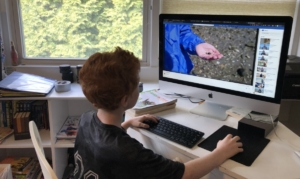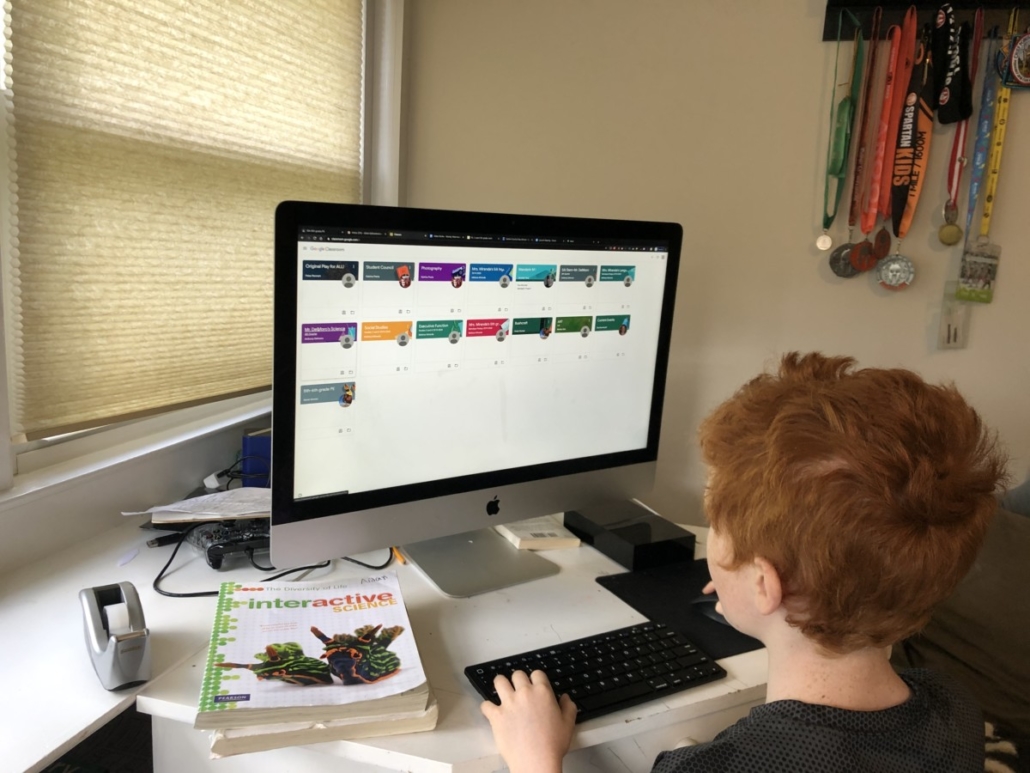Stamford Public Schools have the privilege of working in partnership with SoundWaters through a Virtual Field Trip experience. Teachers are using this content based information in alignment to the Next Generation Science Standards. The lessons have afforded the students to experience the adaptations of the Sound in this unprecedented times. Through the lessons’ outline, questions, and videos provided, the students are connected to the environment around them.
-Natalie Elder McClarty, Stamford Public School Director of Curriculum and Instruction
When You Can’t Come To SoundWaters…
 SoundWaters Distance Learning
SoundWaters Distance Learning
You and your students are trapped at home and you have to figure out how to replace an entire spring’s science curriculum. SoundWaters can help. Using our science library, you can bring Long Island Sound to your students. During spring 2020, when teachers and parents need our help the most, all SoundWaters Distance Learning lessons are available to schools at no charge.
Meeting Next Generation Science Standards
All SoundWaters science content meets Next Generation Science Standards (NGSS). Review the full curriculum calendar to see the NGSS alignments.
SoundWaters Distance Learning means…
Quality
SoundWaters is the #1 choice of schools that study Long Island Sound, welcoming over 30,000 students per year. Our education team will deliver you and your team the highest quality science content focused on our largest local natural environment, Long Island Sound. Each lesson module will take 15-30 minutes for students to complete, including a video lesson, support materials, worksheets and a short quiz. Topic units are customized for grades 3-5 and 6-8.
Consistency
You don’t have to search the internet all spring hoping to find content to piece together for your class. Your SoundWaters content will be strategically created, of the highest quality and it will come to you. Each week, SoundWaters will add one more unit of five new lessons to the library. You just pick and choose which lessons to add to your daily plan for your class on a schedule that works for you – once a day, three times a week, whatever helps you the most. Your curriculum will be coordinated and consistent.
Dependability
Once you have access to the SoundWaters library, you can count on having great science curriculum for the rest of the school year. New, rigorous content will be ready for you every week, delivered on a Google Classroom platform so it’s user-friendly for you, parents and your students. Eight complete units of Long Island Sound science. If you’re going to study the ocean, study your ocean.
A new unit will be added each week.
Unit 1 – Animal Adaptations
Organisms have specific traits that provide advantages for survival in their environment. Observe specific examples from Long Island Sound and discover how habitat affects traits such as feeding, movement, and defense.
Lesson Modules
• Introduction to animal adaptations
• Camouflage
• Aquatic Movement (grades 3-5) & Aquatic Locomotion (grades 6-8)
• Animal senses
• Food chain (grades 3-5) & Food web (grades 6-8)
NGSS Alignments
Interdependent Relationships in Ecosystems: 3-LS2-1, 3-LS4-3
Inheritance and Variation of Traits: 3-LS3-2, 3-LS4-2, 3-LS4-4
Structure, Function, and Information Processing: 4-LS1-1, 4-LS1-2
Matter and Energy in Organisms and Ecosystems: 5-PS3-1, 5-LS1-1, 5-LS2-1
Matter and Energy in Organisms and Ecosystems: MS-LS2-2
Natural Selection and Adaptations: MS-LS4-4
Unit #2 – Human Impact
Humans are dependent on all earth systems, which are connected. Discover the positive and negative effects that result from our use of the environment and ways we can mitigate these changes.
Lesson Modules
• Earth Systems
• Marine Debris
• Microplastics
• Water Movement
• Resource Management
NGSS Alignments
Earth’s Systems: 2-ESS2-1; 2-ESS2-2; 2-ESS2-3
Weather and Climate: 3-ESS3-3
Energy: 4-ESS3-1
Earth’s Systems: 4-ESS1-1; 4-ESS2-1; 4-ESS3-2
Earth’s Systems: 5-ESS2-1, 5-ESS2-2; 5-ESS3-1
Human Impacts: MS-ESS3-3
Unit #3 – Oyster Week
Oysters provide an important service for Long Island Sound. Discover the role they play to the ecosystem and as a marine industry.
Lesson Modules
• What is a mollusk?
• Oyster anatomy
• Oyster Reefs
• Threats to the eastern oyster
• Bioremediation
NGSS Alignments
Ecosystems: 3-LS2-1
Interdependent Relationships in Ecosystems: 3-LS4-3; 3-LS4-4
Structure, Function, and Information Processing: 4-LS1-1
Earth and Human Activity: 5-ESS3-1
Ecosystems: 5-LS2-1
Earth and Human Activity: 5-ESS3
Structures and Processes: MS-LS1-3
Ecosystems: MS-LS2-4; MS-LS2-5
Ecosystems: Interactions, Energy and Dynamics: HS-LS2.C, HS-LS2-7
Biodiversity and Humans: HS-LS4.D
Unit #4 – Physical Oceanography
Bodies of water around the earth are affected by many different factors that also affect the living organisms. Take a closer look at some of these factors and discover how the animals of Long Island Sound are affected by them daily.
Lesson Modules
• Introduction to Oceanography
• Properties of Water
• Tides
• Waves
• Currents + Gyres
NGSS Alignments
Waves and Information: 4-PS4-1;
Structure and Properties of Matter: 5-PS1-3
Earth and the Solar System: 5-ESS1-2
Earth’s Place in the Universe: MS-ESS1-1
Earth’s Systems: MS-ESS2-6
Unit #5 – Marine Ecosystems
The marine environment is a complex series of relationships that affect one another. Explore what makes the Long Island Sound unique and see what data we collect to share with students.
Lesson Modules
•Living and Non-Living Components (Biotic vs Abiotic)
•Coastal Habitats
•Freshwater Bioindicators
•Population Dynamics
•Coastal and Marine Plants
NGSS Alignments
Interdependent Relationships in Ecosystems: 3-LS2-1; 3-LS4-3; 3-LS4-4
Inheritance and Variation of Traits: 3-LS3-2; 3-LS4-2
Structure, Function, and Information Processing: 4-LS1-1
Earth’s Systems: 4-ESS2-1
Matter and Energy in Organisms and Ecosystems: 5-LS1-1; 5-LS2-1
Matter and Energy in Organisms and Ecosystems: MS-LS2-1; MS-LS2-3; MS-LS2-4
Independent Relationships in Ecosystems: MS-LS2-2; MS-LS2-5
Growth, Development, and Reproduction of Organisms: MS-LS1-5
Unit #6 – Climate Change
We can observe daily changes to our local environment, but it’s difficult to see what is happening to the planet. Explore some of the ways that climate change affects both the animals of Long Island Sound and people that live around the world.
Lesson Modules
• Climate vs Weather
• The Greenhouse Gases
• Acidification
• Sea Level Rise
• Alternative Energy
NGSS Alignments
Weather and Climate: 3-ESS2-1; 3-ESS3-1
Earth’s Systems: 5-ESS2-1; 5-ESS3-1
Weather and Climate: MS-ESS2-5; MS-ESS2-6; MS-ESS3-5
Structure and Properties of Matter: MS-PS1-1
Human Impacts: MS-ESS3-4
Unit #7 – Physics & Engineering
Engineering and physics are used to solve many problems in the environment. Discover how humans have adapted these concepts to protect the environment as well as travel above and below the water.
Lesson Modules
• Environmental Engineering
• Marine Engineering
•Biomimicry (3-5)/Bioinspired Design (6-8)
• Simple machines
•Bernoulli’s Principle & the Coriolis Effect
NGSS Alignments
Forces and Interactions: 3-PS2-1; 3-PS2-2
Motion and Stability: 3-PS2-2
Energy: 4-ESS3-1
Earth’s Systems: 4-ESS3-2
Earth and Human Activity: 5-ESS3-1
Unit #8 – Biology
Whether talking about a whole animal or the parts that make it work, all living organisms come from the same basic things. Compare examples of plants and animals to discover how their unique systems of organization help them survive!
Lesson Modules
Introduction to Biology
DNA
Circulatory System (3-5)/Vascular System (6-8)
Digestive System
Life Cycles
NGSS Alignments
Inheritance and Variation of Traits: 3-LS1-1, 3-LS3-1
Unity and Diversity: 3-LS4-2
Structure, Function, and Information Processing: 4-LS1-1
Matter and Energy in Organisms and Ecosystems: 5-LS1-1
From Molecules to Organisms: Structures and Processes: MS-LS1-1, MS-LS1-2; MS-LS1-3; MS-LS1-4


